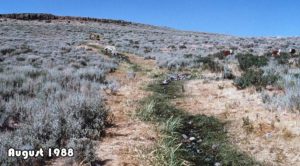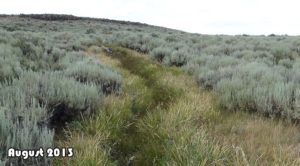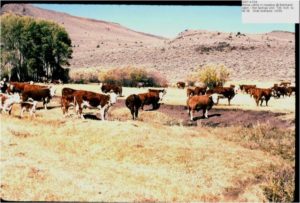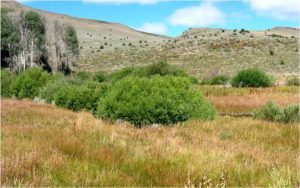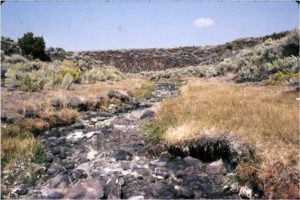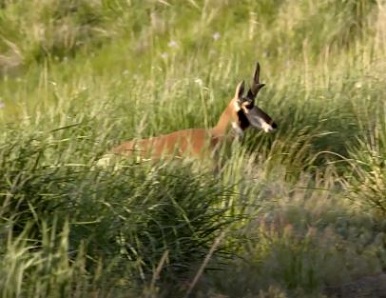
This beautiful pronghorn, a native species, regained its home after cattle were removed from Hart Mountain
Dr. Bill Ripple’s Research Shows the Stark Destruction Caused by Grazing Cattle
Bill Ripple, PhD is Distinguished Professor of Ecology at Oregon State University. Over twenty years ago, he began researching the beneficial effects that wolves in Yellowstone have on that ecosystem. From there, he branched to investigating the key roles of large carnivores in ecological systems around the world. I explored his findings with him on this critical research, especially how it demolishes the fantasy that grass-fed beef is good for our planet.
Everywhere he looked scientifically, Dr. Ripple saw the same profoundly disturbing fact: wild carnivores were being persecuted to protect livestock. Humans, who eat
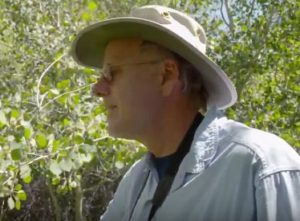
Dr. Bill Ripple shows how aspen have grown back thick and beautiful on Hart Mountain, now that cattle are gone
meat but are biologically designed to eat plants, are killing the predators whose role in a balanced ecosystem is precisely to eat meat. Why? So that humans can consume the prey of actual carnivores.
About the time Dr. Ripple came to this troubling insight, he saw the documentary Forks Over Knives and became vegan immediately, adopting a whole foods, plant-based diet based on foods like beans, rice, corn, quinoa, potatoes, salads, and fruit. I asked him why the film had such a strong impact.
“Like Dr. T Colin Campbell, I grew up in a farming and ranching family,” he shared. “The quality of the evidence that he and Dr. Esselstyn presented in Forks Over Knives moved me completely – I fell in love with the film. It changed the direction of my own research as I worked with scientists around the world on the ecological effects of human carnivory, which means humans eating other animals. Scientists who study predators typically use the term “carnivory,” and I simply extended it to the eating habits of people. About this time, I also became deeply concerned about climate change and wanted to make a contribution to scientific understanding in this

Grass-fed cattle have the biggest impact in raising the level of greenhouse gases, accelerating climate change
area, especially the effects of animal agriculture.”
Grass-fed Beef and Climate
Dr. Ripple quickly began to focus on the impact of ruminants, especially cattle, on climate change. Ruminants are animals that ferment their plant-based food in a special stomach during digestion. Inseparable from this process, ruminants emit methane, a far more potent greenhouse gas than is carbon dioxide. Dr. Ripple had a disturbing realization. “In our research, we found that even with dramatic reductions in carbon dioxide emissions, we can’t meet our climate goals. We need to quickly and drastically reduce other greenhouse gases, especially methane.”
He added, “Research completed by other scientists, including a review of 52 studies of the climate impact of a number of animal and plant foods, shows the ruminants
that humans raise for food are a concentrated source of methane and other greenhouse gases. Comparing greenhouse gas impacts per pound of product produced, grass-fed beef has the strongest food-related impact on climate change, followed by sheep (another ruminant), cattle that are grass-fed part of the year and on a feedlot in winter, and finally cattle that are kept on a feedlot all year. So the popular idea that grass-fed beef does less environmental damage than feedlot beef is actually the reverse of the facts.” See the
graph that Dr. Ripple constructed (above) to illustrate these impacts.
Transformation at Hart Mountain
Beyond methane, the profound effect that removing cattle from the range has on the wildlife and vegetation is strikingly visible in research that Dr. Ripple and colleagues have done at Hart Mountain, a national pronghorn antelope refuge in southeastern Oregon. The U.S. Fish and Wildlife Service site on Hart Mountain proudly proclaims “The 278,000-acre refuge is one of the most expansive wildlife habitats in the arid West free of domestic livestock.”
This wonderful fact was not always so. Until 1990 “grass-fed cattle” dominated the reserve, until they were all removed to allow more resources for pronghorn antelope and other animals whose numbers in the wild were precarious. This created a natural
experiment for Dr. Ripple and his colleagues to study what would happen to a severely degraded ecosystem when cattle were suddenly gone.
The results are astonishing and delightful. The shrubs and trees key to the ecosystem, such as willow and aspen, started growing back, and stream banks were restored when cows stopped trampling them and eating down the plants. Wildlife numbers could rebound as their habitat healed itself. This transformation is
documented by numerous before and after pictures that show a wounded environment at the time when cattle reigned, and green flourishing young trees and grass without livestock present. The destructiveness of so called “grass-fed beef” is undeniable in these before-and-after photo pairs with this article.
Like the ecosystem, research shows your own body’s healing powers are being activated when you remove food-borne causes of illness. Dr. Ripple is fascinated by the parallels between environmental and human health recovery. “When you stop eating animal products, studies show your arteries can reopen and health problems vanish with the blockages. Just as we saw at Hart Mountain – get rid
of the cattle, and streams will be beautifully restored in the landscape.”
You can learn more about Dr. Ripple’s work and see a short, dramatic video on Hart Mountain at his youtube channel Bill Ripple Ecology.
If you enjoyed this article, you may want to read more on the killing of wildlife to give their homes to cattle for the profit of ranchers. You can stop this practice by simply not buying beef.
Intrigued? Now you can use our Whole Foods Blog Finder to target informative, fun
postings on whole foods, plant-based diets. Quick information at no cost!
Post written by Janice Stanger, Ph.D. Janice authored The Perfect Formula Diet: How to Lose Weight and Get Healthy Now With Six Kinds of Whole Foods. This book will outline a wonderful whole foods, plant-based diet free of the devastation of grass-fed beef. Bring back wildlife and make the West beautiful again. A version of this article (also authored by Janice Stanger) was published on the Forks Over Knives site under a different title.
Tags: Dr. Bill Ripple, Forks Over Knives, grass fed beef, Hart Mountain
